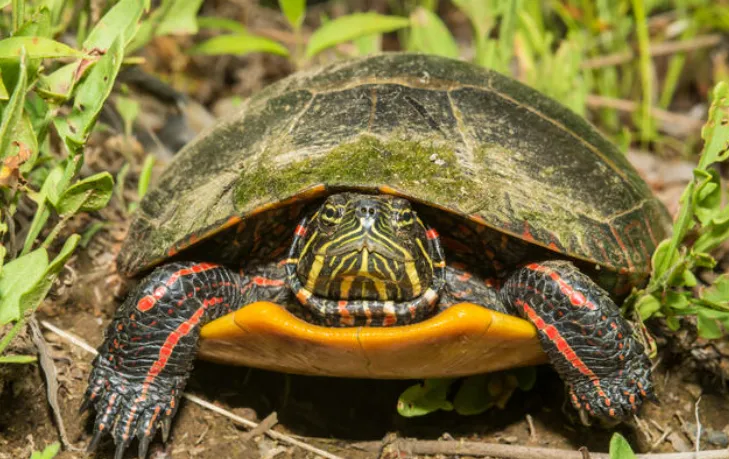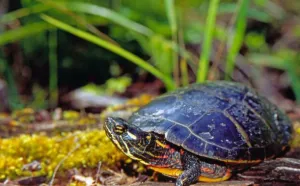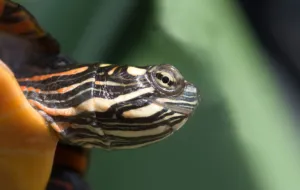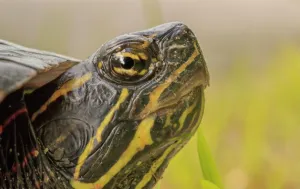
Table of Contents
Scientific Classification
- Kingdom: Animalia
- Phylum: Chordata
- Class: Reptilia
- Order: Testudines
- Family: Emydidae
- Genus: Chrysemys
- Species: Chrysemys picta picta
Quick Overview
The Eastern Painted Turtle (Chrysemys picta picta) is a vibrant freshwater turtle, celebrated for its captivating colors and widespread distribution. As a subspecies of the Painted Turtle, it shares many characteristics with its relatives while exhibiting unique features that make it a fascinating member of the Chrysemys genus.
Fast Facts
- Scientific Name: Chrysemys picta picta
- Lifespan: Can live for several decades, often exceeding 20 years with proper care.
- Average Size: Adult Eastern Painted Turtles typically have a shell length of 4 to 7 inches.
- Diet: Omnivorous, consuming a diverse diet of aquatic plants, small fish, insects, and invertebrates.
- Habitat: Aquatic, commonly found in ponds, lakes, slow-moving rivers, and marshes.
Did you know?
The Eastern Painted Turtle’s vibrant shell markings are not only for aesthetics; they serve as effective camouflage in their natural habitats.
Appearance
Eastern Painted Turtles showcase a captivating appearance with a smooth, olive to black shell adorned with bright red and yellow markings. Their skin often displays a mix of dark and light patterns, and their undersides (plastrons) are typically yellow with dark markings. The distinctive and vibrant colors contribute to their popularity among turtle enthusiasts.
Size and Weight
Adult Eastern Painted Turtles typically reach a shell length of 4 to 7 inches, with females generally being slightly larger than males. Their weight varies but is usually between 300 and 500 grams.

Temperament and Behavior
Known for their calm demeanor, Eastern Painted Turtles are excellent swimmers and are often observed basking on rocks or logs. While they may be somewhat shy, they can become accustomed to human presence, especially during feeding times.
Fun Fact
Eastern Painted Turtles are skilled baskers, often seen stacking on top of each other on a sunny log, creating a striking visual display.
Habitat and Distribution
Native to the eastern part of North America, Eastern Painted Turtles are versatile in their choice of habitats, thriving in various aquatic environments ranging from ponds and lakes to slow-moving rivers and marshes.
Care Guide
For those interested in keeping Eastern Painted Turtles as pets:
- Enclosure: Provide a well-structured aquatic habitat with a basking area, UVB lighting, and a water filtration system.
- Temperature: Maintain a basking area temperature around 85-90°F (29-32°C) and water temperature around 75-80°F (24-27°C).
- Diet: Offer a balanced diet, including commercial turtle pellets, leafy greens, insects, and aquatic plants.
- Health Check-ups: Regularly monitor your pet’s health, including eyes, nose, and shell, and seek veterinary care when needed.
Diet and Nutrition
Eastern Painted Turtles thrive on a diverse diet that includes commercial turtle pellets, leafy greens, aquatic plants, and protein sources like insects or small fish. Calcium supplements may be necessary for their overall health.
Health and Wellness
Maintaining proper humidity, a balanced diet, and access to sunlight or UVB lighting are essential for the overall health and well-being of Eastern Painted Turtles.
Reproduction
Eastern Painted Turtles reproduce by laying eggs in sandy or loamy soil. The gender of the offspring is influenced by the incubation temperature.
Conservation Status
While not currently classified as endangered, Eastern Painted Turtles face threats such as habitat loss and road mortality. Conservation efforts focus on preserving their natural habitats.
Photo Gallery




Related Profiles
Share This Profile
Three Fascinating Facts About Eastern Painted Turtles
- Distinctive Regional Variations: Eastern Painted Turtles exhibit subtle variations in coloration and pattern depending on their specific geographic location.
- Survival Adaptations: These turtles have adapted to various environmental conditions, from surviving in slow-moving waters to navigating through marshy terrains.
- Communication through Touch: Eastern Painted Turtles use tactile communication, often gently touching each other’s limbs or faces, especially during courtship or territorial interactions.
- Enchi Ball Python: A Unique and Stunning Morph of Python regius - March 27, 2025
- Emerald Tree Monitor: The Enigmatic Green Guardian of the Rainforest - March 26, 2025
- The Egyptian Cobra (Naja haje): A Fascinating Serpent - March 25, 2025
